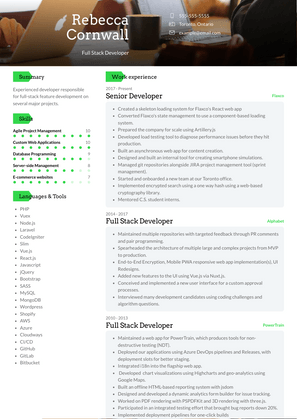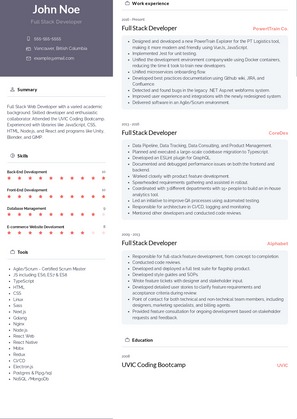Full Stack Developer Resume Examples & Samples for 2025
This page provides you with Full Stack Developer resume samples to use to create your own resume with our easy-to-use resume builder. Below you'll find our how-to section that will guide you through each section of a Full Stack Developer resume.


What Do Hiring Managers Look for in a Full Stack Developer Resume?
- Proficiency in both front-end and back-end technologies (e.g., HTML, CSS, JavaScript, Python, Java).
- Experience with frameworks and libraries like React, Angular, Node.js, and Django.
- Strong database management skills (SQL, MongoDB, PostgreSQL).
- Familiarity with DevOps tools and cloud platforms (e.g., AWS, Docker, Kubernetes).
- Proven ability to build, test, and deploy scalable web applications.
- Strong problem-solving and team collaboration skills.
How to Write a Full Stack Developer Resume?
To write a professional Full Stack Developer resume, follow these steps:
- Select the right Full Stack Developer resume template.
- Write a professional summary highlighting your technical expertise, achievements, and experience.
- Include a section detailing your experience with programming languages, frameworks, and tools.
- Follow the STAR method to describe your work experience, focusing on completed projects and their impact.
- Highlight technical skills such as full-stack frameworks, database management, and deployment tools in a dedicated skills section.
- Include education, certifications, and training relevant to software and web development.
How to Write Your Full Stack Developer Resume Header?
Write the perfect Full Stack Developer resume header by:
- Adding your full name prominently at the top.
- Including a professional photo if it aligns with industry norms in your region.
- Adding your current or most relevant developer role title.
- Providing contact information: city, phone number, professional email address, and a LinkedIn or GitHub profile link.
Bad Full Stack Developer Resume Example - Header Section
John Doe 123 WebDev St. Email: coderking@email.com, Instagram: @codegenius123
Good Full Stack Developer Resume Example - Header Section
John Doe, San Francisco, CA, Phone: +1-555-555-5555, Email: john.doe@email.com, LinkedIn: linkedin.com/in/johndoe, GitHub: github.com/johndoe
How to Write a Professional Full Stack Developer Resume Summary?
Use this template to craft a compelling Full Stack Developer resume summary: "Full Stack Developer with [number of years] years of experience in [specific areas, e.g., e-commerce platforms, SaaS applications]. Expert in [key skills, e.g., React, Node.js, MongoDB]. Proven success in [key achievement or project]."
Examples:
- "Full Stack Developer with 6+ years of experience building scalable web applications. Proficient in React, Node.js, and PostgreSQL. Successfully reduced page load times by 30% for a high-traffic e-commerce platform."
- "Experienced Full Stack Developer with expertise in building SaaS applications using Angular, Python, and AWS. Led a team to develop a subscription-based product, increasing client retention by 20%."
How to Write a Full Stack Developer Resume Experience Section?
Here’s how to structure an impactful Full Stack Developer resume experience section:
- Present work experience in reverse chronological order.
- Use bullet points for clarity, focusing on projects and their outcomes.
- Quantify achievements wherever possible (e.g., improved system performance by 25%, developed a platform with 10k+ daily users).
- Emphasize expertise in frameworks, databases, and cloud technologies.
- Use action verbs such as "Developed," "Implemented," "Optimized," or "Designed."
Full Stack Developer Resume Example
Senior Full Stack Developer
- Developed and deployed a scalable web application using React and Node.js, increasing site traffic by 40%.
- Designed a cloud-based microservices architecture using AWS and Docker.
- Collaborated with UX/UI designers to enhance the user interface, improving customer satisfaction scores by 25%.
Full Stack Developer Resume Example
Full Stack Developer
- Built RESTful APIs to support data integration between multiple platforms.
- Optimized database queries, reducing response time by 30%.
- Created reusable components in Angular to streamline the development process.
Additional Sections for a Full Stack Developer Resume
- Certifications (e.g., AWS Certified Developer, Microsoft Azure, Google Cloud Certification)
- Technical Projects (e.g., personal or open-source projects)
- Awards and Recognitions
- Languages (if applicable)
Top Full Stack Developer Resume Skills for 2025
- Front-End Development (HTML, CSS, JavaScript)
- Frameworks and Libraries (React, Angular, Vue.js)
- Back-End Development (Node.js, Django, Ruby on Rails)
- Database Management (SQL, MongoDB)
- RESTful and GraphQL APIs
- Cloud Platforms (AWS, Azure, GCP)
- DevOps Tools (Docker, Kubernetes)
- Version Control (Git, GitHub)
- Unit Testing and Debugging
- Agile Development
How Long Should My Full Stack Developer Resume Be?
Full Stack Developer resumes typically range from one to two pages. Focus on technical expertise, certifications, and impactful projects to create a concise and effective document.
For assistance, consider using our resume builder or explore Full Stack Developer resume examples to get started.
Emerging Technologies for a Full Stack Developer Resume
Highlight your experience with the latest technologies in full-stack development, showcasing adaptability and innovation.
Examples:
- “Integrated AI algorithms for predictive analytics into a SaaS application, improving decision-making speed by 30%.”
- “Developed Web3 decentralized applications using Solidity and Ethereum, enhancing blockchain solutions.”
Quantifiable Achievements for a Full Stack Developer Resume
Provide measurable results to emphasize the value of your contributions.
Examples:
- “Optimized backend database queries, reducing API response time by 40% and enhancing user experience.”
- “Redesigned an e-commerce platform, increasing conversion rates by 25%.”
Leadership and Team Collaboration for a Full Stack Developer Resume
Highlight your ability to work with cross-functional teams and lead technical projects.
Examples:
- “Managed a team of five developers to deliver a B2B portal two weeks ahead of schedule.”
- “Collaborated with designers and QA teams to ensure seamless product launches.”
Industry-Specific Applications for a Full Stack Developer Resume
Showcase your expertise in building solutions tailored to specific industries.
Examples:
- “Developed a fintech platform enabling real-time financial analytics, increasing transaction speeds by 20%.”
- “Created a healthcare application that streamlined patient data management, reducing admin overhead by 15%.”
Open-Source Contributions for a Full Stack Developer Resume
Highlight contributions to open-source projects to showcase community involvement and technical expertise.
Examples:
- “Contributed to the Vue.js framework by optimizing component rendering, resulting in 2K+ stars on GitHub.”
- “Published a library for API testing in Python, adopted by 50+ developers globally.”
Soft Skills for a Full Stack Developer Resume
Emphasize your ability to communicate technical concepts and collaborate with non-technical teams.
Examples:
- “Effectively presented complex technical roadmaps to stakeholders, facilitating informed decision-making.”
- “Translated client requirements into actionable development plans, ensuring on-time delivery.”
Cloud-Native Development for a Full Stack Developer Resume
Demonstrate your experience in building and deploying cloud-native applications to highlight your technical versatility.
Examples:
- “Designed and deployed a cloud-native microservices architecture using Kubernetes, Docker, and AWS Lambda.”
- “Implemented scalable serverless functions on Google Cloud Platform, reducing infrastructure costs by 30%.”
DevOps and CI/CD Expertise for a Full Stack Developer Resume
Showcase your ability to integrate development and operations through automation and continuous delivery.
Examples:
- “Set up CI/CD pipelines using Jenkins and GitHub Actions, accelerating deployment frequency by 50%.”
- “Automated infrastructure provisioning with Terraform, ensuring consistent environment setups.”
Testing and Quality Assurance for a Full Stack Developer Resume
Highlight your proficiency in testing frameworks and ensuring code quality.
Examples:
- “Integrated automated testing frameworks such as Jest and Selenium, reducing regression bugs by 40%.”
- “Collaborated with QA teams to implement end-to-end testing pipelines, improving product reliability by 25%.”
API Development and Integration for a Full Stack Developer Resume
Emphasize your expertise in creating and integrating APIs, a critical aspect of full-stack development.
Examples:
- “Developed RESTful APIs to handle high-volume requests, improving application performance by 30%.”
- “Implemented GraphQL APIs for optimized data querying, reducing client-server payload sizes by 50%.”
Cross-Browser and Mobile Optimization for a Full Stack Developer Resume
Show your ability to ensure seamless functionality across devices and browsers.
Examples:
- “Optimized web applications for cross-browser compatibility, achieving a 20% increase in user engagement.”
- “Enhanced mobile responsiveness using Bootstrap and media queries, improving mobile user retention by 35%.”
Security Best Practices for a Full Stack Developer Resume
Highlight your understanding of security principles to ensure the safety of web applications.
Examples:
- “Implemented OWASP-compliant security measures, reducing vulnerabilities by 50%.”
- “Configured secure authentication using OAuth 2.0 and JWT, enhancing data protection across systems.”
Performance Optimization for a Full Stack Developer Resume
Demonstrate your ability to improve application performance and scalability.
Examples:
- “Refactored backend logic to reduce API latency by 60%, improving real-time application performance.”
- “Optimized front-end asset loading with Webpack, decreasing page load times by 40%.”
Accessibility and Inclusivity for a Full Stack Developer Resume
Highlight your commitment to creating applications that are accessible to all users.
Examples:
- “Integrated WCAG 2.1 guidelines into front-end design, ensuring accessibility for users with disabilities.”
- “Added ARIA attributes to improve screen reader compatibility, enhancing user experience for visually impaired users.”
-
What Do Hiring Managers Look for in a Full Stack Developer Resume?
-
How to Write a Professional Full Stack Developer Resume Summary?
-
How to Write a Full Stack Developer Resume Experience Section?
-
Leadership and Team Collaboration for a Full Stack Developer Resume
-
Industry-Specific Applications for a Full Stack Developer Resume
-
DevOps and CI/CD Expertise for a Full Stack Developer Resume
-
Testing and Quality Assurance for a Full Stack Developer Resume
-
API Development and Integration for a Full Stack Developer Resume
-
Cross-Browser and Mobile Optimization for a Full Stack Developer Resume
-
Accessibility and Inclusivity for a Full Stack Developer Resume
Copyright ©2025 Workstory Inc.
